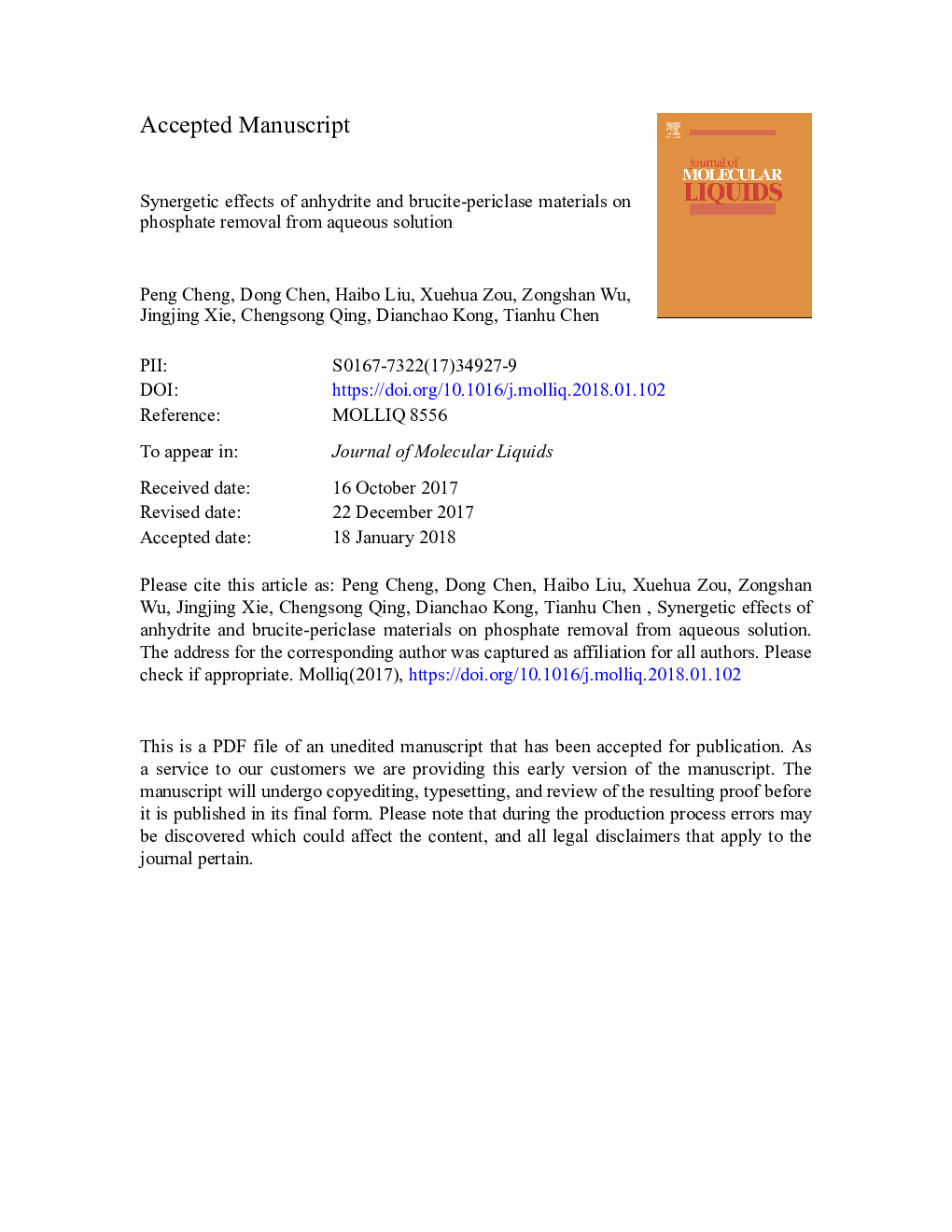| کد مقاله | کد نشریه | سال انتشار | مقاله انگلیسی | نسخه تمام متن |
|---|---|---|---|---|
| 7842956 | 1506517 | 2018 | 28 صفحه PDF | دانلود رایگان |
عنوان انگلیسی مقاله ISI
Synergetic effects of anhydrite and brucite-periclase materials on phosphate removal from aqueous solution
ترجمه فارسی عنوان
اثرات هم افزایی مواد انیدریت و بروسیت پریکلاس بر حذف فسفات از محلول های آبی
دانلود مقاله + سفارش ترجمه
دانلود مقاله ISI انگلیسی
رایگان برای ایرانیان
کلمات کلیدی
انیدریت، مواد بروسیت پریکلاس، حذف فسفات، جنبشی، ایزوترم
موضوعات مرتبط
مهندسی و علوم پایه
شیمی
شیمی تئوریک و عملی
چکیده انگلیسی
The objectives of this study were to prepare brucite-periclase material (BPM), and a cost-effective anhydrite-BPM sorbent (ABPM) for the removal of phosphate. The samples were characterized by X-Ray Diffraction (XRD), X-ray fluorescence (XRF), BET surface area, scanning electron microscope (SEM), and transmission electron microscope (TEM). The characterization results show that the BPM was successfully prepared after calcination and hydration, with flaky structure transforming into ellipsoidal structural aggregation. The effects of mixed mass ratios, reaction time, pH, co-existing anions, humid acid and initial phosphate concentration on phosphate removal were investigated by batch experiments. The kinetic adsorption process was well described by pseudo-second-order model with high correlation coefficient (R2â¯>â¯0.99). The Langmuir model provided a better described for the adsorption process than the Freundlich model. The maximum phosphate adsorption capacity was 23.66, 24.96 and 26.14â¯mg·gâ1 at 298â¯K, 303â¯K and 308â¯K, respectively, with a 99% removal rate. The P concentration after adsorption was lower than 0.1â¯mgâLâ1 when the initial P concentration was 10â¯mgâLâ1.The significant synergetic effects of BPM on anhydrite were observed: firstly, the significant improvement of phosphate removal rate (99.28%) of ABPM can be observed, compared with anhydrite (1.26%) and BPM (45.10%); secondly, a special sustained-release effect was described by the Stumm kinetic mode and an alkaline environment was proved to be made by BPM; finally, the adsorption and precipitation sites were provided by BPM. Thus, the mechanism of phosphorus removal is suggested by two steps: chemical adsorption and Ca-phosphate precipitation. Firstly, the phosphate adsorbed on the BPM by chemical adsorption as the precursor; secondly, the amorphous calcium phosphate compounds formed as the precursors of hydroxyapatite and the phosphate was immobilized by chemical precipitation.
ناشر
Database: Elsevier - ScienceDirect (ساینس دایرکت)
Journal: Journal of Molecular Liquids - Volume 254, 15 March 2018, Pages 145-153
Journal: Journal of Molecular Liquids - Volume 254, 15 March 2018, Pages 145-153
نویسندگان
Peng Cheng, Dong Chen, Haibo Liu, Xuehua Zou, Zongshan Wu, Jingjing Xie, Chengsong Qing, Dianchao Kong, Tianhu Chen,
